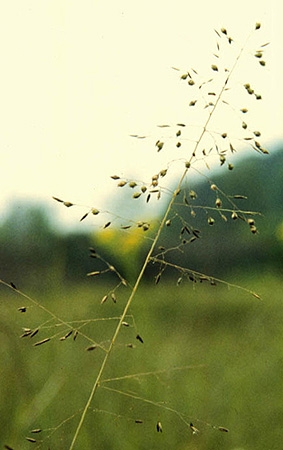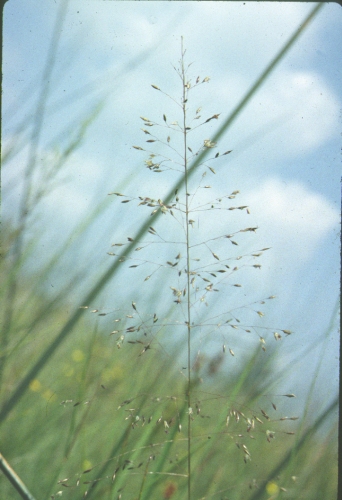Plants and Animals
Sporobolus heterolepis Prairie dropseed
Key Characteristics
Densely tufted grass of moist prairies and alvar; leaves very narrow and often inrolled, up to 50 cm tall; fruiting culms up to 1 m tall, bearing small spherical grains on an open, branching panicle.
Status and Rank
US Status: No Status/Not Listed
State Status: SC - Special Concern (rare or uncertain; not legally protected)
Global Rank: G5 - Secure
State Rank: S3 - Vulnerable
Occurrences
| County | Number of Occurrences | Year Last Observed |
|---|---|---|
| Allegan | 2 | 2013 |
| Chippewa | 6 | 2001 |
| Crawford | 1 | 1993 |
| Delta | 3 | 1990 |
| Eaton | 1 | 1999 |
| Jackson | 5 | 2014 |
| Kalamazoo | 3 | 2020 |
| Kalkaska | 2 | 2023 |
| Lenawee | 2 | 2025 |
| Livingston | 3 | 2007 |
| Macomb | 1 | 1978 |
| Oakland | 1 | 1985 |
| Oceana | 1 | 2023 |
| Van Buren | 3 | 2005 |
| Washtenaw | 4 | 2013 |
Information is summarized from MNFI's database of rare species and community occurrences. Data may not reflect true distribution since much of the state has not been thoroughly surveyed.
Habitat
In Michigan, prairie dropseed is known from a variety of habitats, including prairie fens in the southern Lower Peninsula, in mesic sand prairies surrounded by pine barrens in the northern Lower Peninsula, and in alvar grasslands in the Upper Peninsula, where this species comprises an important portion of the thin turfs formed over limestone and dolomite bedrock.
Natural Community Types
- Alvar
- Limestone bedrock glade
- Limestone bedrock lakeshore
- Mesic sand prairie
- Prairie fen
- Wet-mesic sand prairie
For each species, lists of natural communities were derived from review of the nearly 6,500 element occurrences in the MNFI database, in addition to herbarium label data for some taxa. In most cases, at least one specimen record exists for each listed natural community. For certain taxa, especially poorly collected or extirpated species of prairie and savanna habitats, natural community lists were derived from inferences from collection sites and habitat preferences in immediately adjacent states (particularly Indiana and Illinois). Natural communities are not listed for those species documented only from altered or ruderal habitats in Michigan, especially for taxa that occur in a variety of habitats outside of the state.
Natural communities are not listed in order of frequency of occurrence, but are rather derived from the full set of natural communities, organized by Ecological Group. In many cases, the general habitat descriptions should provide greater clarity and direction to the surveyor. In future versions of the Rare Species Explorer, we hope to incorporate natural community fidelity ranks for each taxon.
Associated Plants
Tamarack, grass-of-parnassus, shrubby cinquefoil, Virginia mountain mint, Ohio goldenrod, Riddell's goldenrod, Indian grass, hardstem bulrush, three-square, twig-rush, small white lady's slipper, bog valerian, little bluestem, big bluestem, colic root, wild indigo, common horsetail, path rush, hairy pinweed, pale spiked lobelia, meadowsweet, bulrush sedge, flattened spike-rush, ragwort, cat's foot, Canadian milk vetch, harebell, sedges, Indian paintbrush, field chickweed, bastard toad flax, hair grass, prairie smoke, ground juniper, bee-balm, and old field goldenrod.
Management Recommendations
This species requires protection of hydrology, groundwater source, and natural disturbance regime. It also benefits from management that includes prescribed fire and brush removal, which maintains open habitat and reduces competing woody vegetation. Control invasive species, especially glossy buckthorn. Where this species occurs in alvar habitat, it may be susceptible to damage from excessive recreational use and foot traffic.
Survey Methods
Random meander search covers areas that appear likely to have rare taxa, based on habitat and the judgement of the investigator.
-
Meander search
-
Survey Period: From first week of August to third week of September
-
References
Survey References
- Elzinga, C.L., D.W. Salzer, and J.W. Willoughby. 1998. Measuring and Monitoring Plant Populations. The Nature Conservancy and Bureau of Land Management, Denver. BLM Technical Reference 1730-1. 477pp.
- Goff, G.F., G.A. Dawson, and J.J. Rochow. 1982. Site examination for Threatened and Endangered plant species. Environmental Management 6(4): 307-316
- Nelson, J.R. 1984. Rare Plant Field Survey Guidelines. In: J.P. Smith and R. York. Inventory of rare and endangered vascular plants of California. 3rd Ed. California Native Plant Society, Berkeley. 174pp.
- Nelson, J.R. 1986. Rare Plant Surveys: Techniques For Impact Assessment. Natural Areas Journal 5(3):18-30.
- Nelson, J.R. 1987. Rare Plant Surveys: Techniques for Impact Assessment. In: Conservation and management of rare and endangered plants. Ed. T.S. Elias. California Native Plant Society, Sacramento. 8pp.
Technical References
- Deam, C. C. 1940. Flora of Indiana. Department of Conservation, Indianapolis. 1236pp.
- Flora of North America Editorial Committee. 2003. Flora of North America, North of Mexico. Volume 25: Magnoliaphyta: Commelinidae (in part): Poaceae, part 2. Oxford University Press, New York. 783pp.
- Gleason, H. A., and A. Cronquist. 1991. Manual of Vascular Plants of Northeastern United States and Adjacent Canada. 2nd Ed. The New York Botanical Garden, New York, New York.
- Gray, A. 1950. Gray's Manual of Botany; eighth ed. Van Nostrand Reinghold, New York. 1632pp.
- Hitchcock, A. S. 1951. Manual of the Grasses of the United States. Second ed. Revised by A. Chase. U.S. Department of Agriculture Miscellaneous Publications 200. 1051pp.
- Holmgren, N.H. 1998. Illustrated Companion to Gleason and Cronquist's Manual. Illustrations of the vascular plants of Northeastern United States and adjacent Canada. New York Botanical Garden, Bronx. 937pp.
- Mohlenbrock, R.H. 1986. Guide to the Vascular Flora of Illinois. Southern Illinois University Press, Carbondale. 507pp.
- Swink, F. and G. Wilhelm. 1994. Plants of the Chicago Region, 4th ed. Indiana Academy of Science, Indianapolis. 921pp.
- Voss, E. G. 1972. Michigan Flora. Part I. Gymnosperms and Monocots. Bulletin of the Cranbrook Institute of Science and University of Michigan Herbarium. 488pp.



